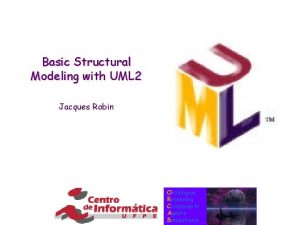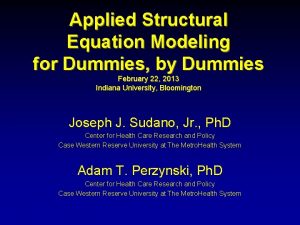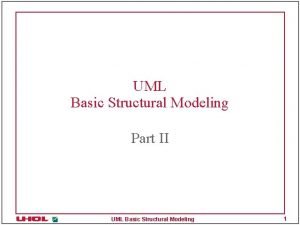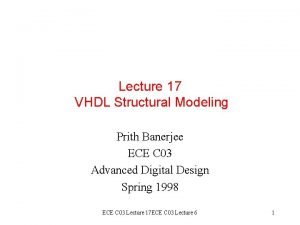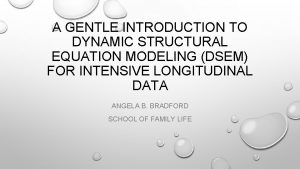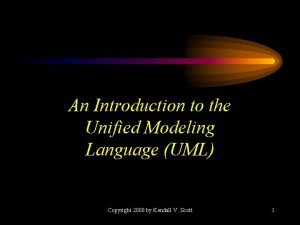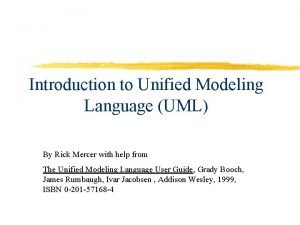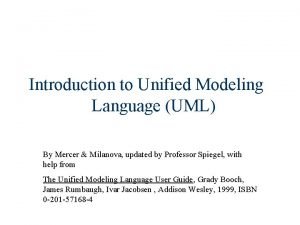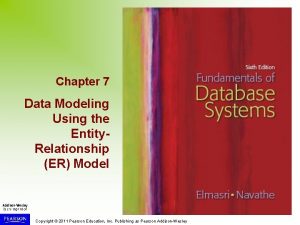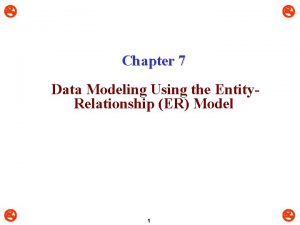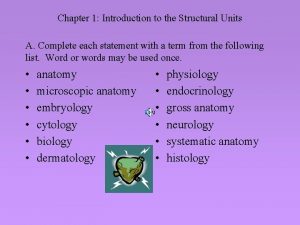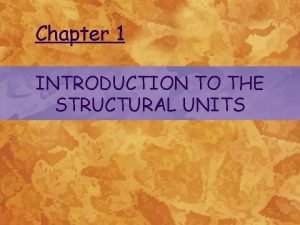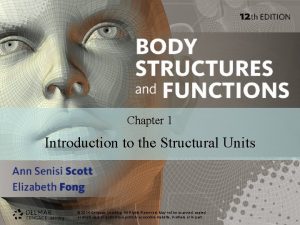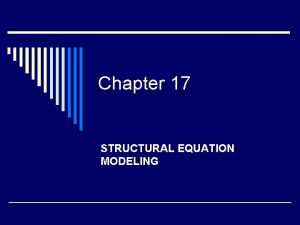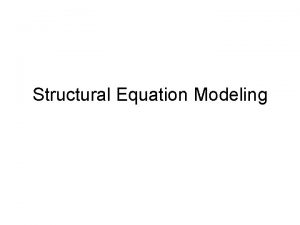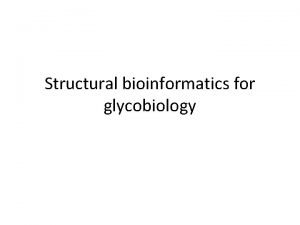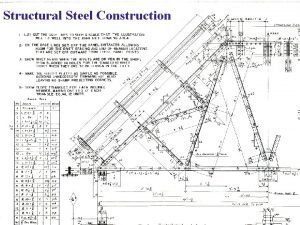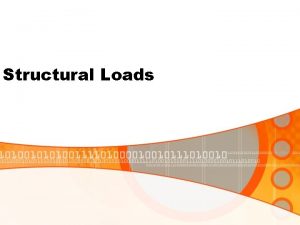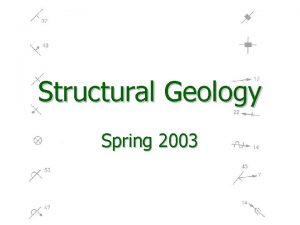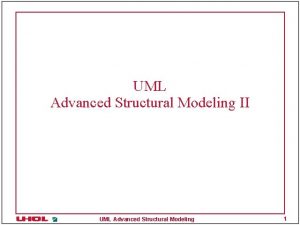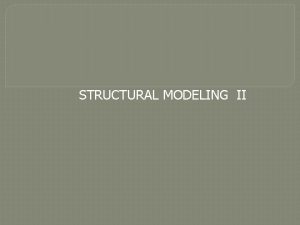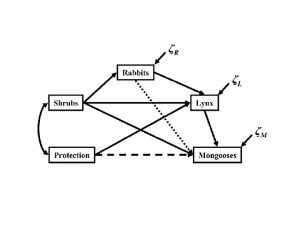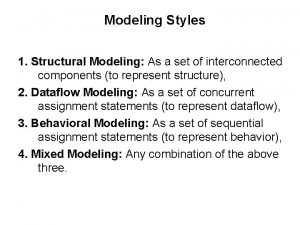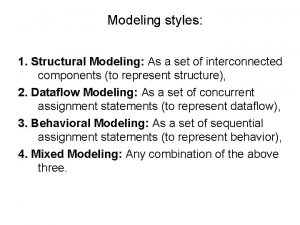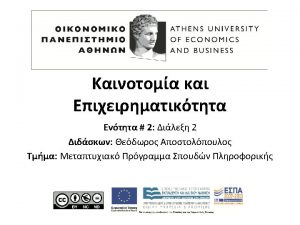Structural Modeling Introduction A Structural model is a

















- Slides: 17

Structural Modeling

Introduction • A Structural model is a formal way of representating the objects that are used and created by a business system • One of the primary purposes of the structural model is to create a vocabulary that can be used by analyst and the user

Classes • Templates for creating instances or objects • Concrete • Abstract • Classes represent real world thing. Typical examples include: • Application domain, user interface, data structure, file structure, operating environment, document, and multimedia classes Slide 3

Attributes & Operations • Attributes • Units of information relevant to the description of the class • Only attributes important to the task should be included • Operations (Methods) • Action that instances/objects can take • Focus on relevant problem-specific operations (at this point) Slide 4

Relationships • Generalization • Enables inheritance of attributes and operations. • Generalization is represented with a-kind-of relationship • Example: we say an employee is a-kind-of-person • Aggregation • Relates parts to wholes • Aggregation represents: a-part-of, a-member-of, contained-in, related-to, and associated-with • Association • Other relationships that do not neatly fit into generalization (a-kindof) or aggregation (a-part-of) Slide 5

Your Turn • What classes, attributes, and operations that would be required to describe the process of registration for campus housing? Slide 6

Responsibilities and Collaborations • Responsibilities • Knowing responsibilities are those things that an instance of a class must be capable of knowing • An instance typically knows the values of its attributes and its relationships • Doing responsibilities are those things that an instance of a class must be capable of doing. • An instance of a class can execute its operations, or it can request a second instance • Collaboration • Objects working together to service a request Slide 7

Class Diagram Syntaks

A CRC Card Front: Class name: ID: Type: Description: Responsibilities: Collaborators: Back: Attributes: Relationships: Generalization (a-kind-of): Aggregation (has-parts): Other Associations: Slide 9

A Class • Represents a kind of person, place, or thing about which the system will need to capture and store information • Has a name typed in bold and centered in its top compartment • Has a list of attributes in its middle compartment • Has a list of operations int its bottom compartment • Does not exlicitly show operations that are available to all classes

An Attribute • Represents properties that describe the state of an object • Can be derived from other attributes, shown by placing a slash before the attribute’s name

Object identification • Textual Analysis is an analysist of the text in the use-case description • Brainstorming: process of set of individuals sitting around table and suggesting potential classes that could be useful for problem under consideration • Common Object List is simply a list of objects common to business domain of system • Pattern is a simply a useful group of collaborating classes that provide a solution to a commonly occuring problem

An Operation • Represents the actions or functions that a class can perform • Can be classified as a contructor, query, or update operation • Includes parentheses that may contain paremeters of information needed to perform the operation

An Association • Represents a relationship between multiple classes or a class and itself • Is labeled using a verb phrase or a role name, whichecer better represents the relationship • Can exist between one or more classess • Contains multiplicity symbols, which represent the minimum and maximum times a class instance can be associated with the related class instance

A generalization • Represents a-kind-of relationship between multiple classes

An Aggregation • Represents a logical a-part-of relationship between multiple classes or a class itself • Is a special form of an association

A composition • Represents a physical a-part-of relationship between multiple classes or a class itself • Is a special form of an association
 Role modeling theory
Role modeling theory Relational vs dimensional data modeling
Relational vs dimensional data modeling Structural modeling in uml
Structural modeling in uml Sem for dummies
Sem for dummies Common mechanisms in basic structural modeling
Common mechanisms in basic structural modeling Structural equation modeling
Structural equation modeling Structural modeling vhdl
Structural modeling vhdl Dynamic structural equation modeling
Dynamic structural equation modeling Introduction to the unified modeling language
Introduction to the unified modeling language Introduction to modeling and simulation
Introduction to modeling and simulation Contoh proses stokastik dalam kehidupan sehari-hari
Contoh proses stokastik dalam kehidupan sehari-hari Introduction to unified modeling language
Introduction to unified modeling language Introduction to unified modeling language
Introduction to unified modeling language Data modeling using entity relationship model
Data modeling using entity relationship model Data modeling using the entity relationship model
Data modeling using the entity relationship model Chapter 1 introduction to the structural units answer key
Chapter 1 introduction to the structural units answer key Chapter 1 introduction to the structural units
Chapter 1 introduction to the structural units Chapter 1 introduction to the structural units
Chapter 1 introduction to the structural units


